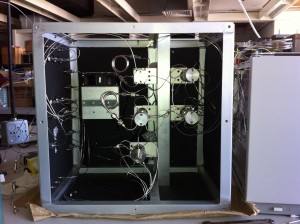Atmospheric methane (CH4) and (N2O) are major long-lived greenhouse gas and have the second and third highest radiative forcing after carbon dioxide (CO2). A positive radiative forcing means that the atmosphere is being warmed, while a negative forcing means that cooling is occur. All greenhouse gases have a positive radiative forcing and contribute to warming of the Earth system. CH4 and N2O are the most abundant greenhouse gases after CO2 and in addition to warming the planet, also play significant roles in the chemistry of the atmosphere and ozone layer. They are quite complicated gases to understand because their sources involve the natural Earth system. A large fraction of CH4 is emitted from wetlands and N2O from the ocean. However, humans in addition to directly emitting these gases, also play a significant role in altering the natural systems. SF6, on the other hand, is almost entirely emitted anthropogenically, or by humans. While the relative concentrations are only about 7 parts per trillion (0.0000000007%), each molecule of SF6 is about 20,000 times more potent than CO2. Despite their low concentrations in the atmosphere, these “industrial” gases have a measurable effect due to their high potency.
Several surface greenhouse gas measurement networks have been monitoring CH4 concentrations for several decades; however, only recently has any measurement program existed in India. As part of my Ph.D, I built an automated, custom GC system to measure methane (CH4), nitrous oxide (N2O) and sulfur hexafluoride (SF6) in India in situ, that is directly at a field site in Darjeeling India. A GC contains columns, which separate air into its various components, so that the compounds of interest (e.g. CH4, or N2O or SF6) come out earlier and all other components of air come out later. By separating in time and passing the components through a detector, we can selectively measure certain gases, instead of the bulk “air.” CH4 is measured on a flame ionization detector and N2O and SF6 on an electron capture detector. A flame ionization detector works by using a small, powerful flame to ionize (or creating charged particles) CH4. A voltage is applied and the current produced by the ions can be measured. An electron capture detector works by creating a stream of electrons using ß radiation. Both N2O and SF6 have high affinity for electrons and “capture” some of the electrons present in the stream. This decrease in current, which is measured, is proportional to the concentration of N2O or SF6 present. Air is sampled every 12 minutes and calibrated (that is, measured against a known reference) and results in about 60 measurements per day. This information is highly valuable because it allows us to infer the emissions of these gases.
CH4 and CO2 are also measured on an optical Cavity Ring Down Spectrometer (CRDS). As part of my work on the UK’s DECC network, I help to operate three Picarro CRDS instruments around the UK. The CRDS principle is different from that of a GC because it uses two lasers, each tuned with a specific infrared wavelength where the gas of interest absorbs, and measures the amount of time it takes light to decay in a cavity. The amount of time is dependent on the amount of gas in the cell. The principals of Picarro’s CRDS system can be read about in more detail here.

